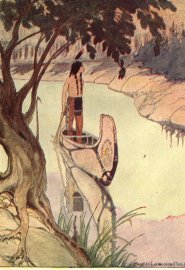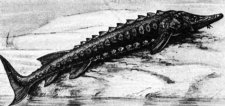(No. 4 in my series)
Now Playing: The Song of Hiawatha
Topic: Nature and Our World
My father once gave me a beautifully illustrated leather-bound book of Henry Wadsworth Longfellow's poems. It was old and the cover was falling apart but I took it to school as we were studying poetry in the sixth form. Stupidly, I allowed myself to be persuaded to lend it to another girl towards the end of term - and that was the last I ever saw of my book! I particularly loved, "The Song of Hiawatha", and that was where I first learnt about the sturgeon, that most ancient of fishes:-
 | On the white sand of the bottom Lay the monster Mishe-Nahma, Lay the sturgeon, King of Fishes; Through his gills he breathed the water, With his fins he fanned and winnowed, With his tail he swept the sand-floor. There he lay in all his armor; On each side a shield to guard him, Plates of bone upon his forehead, Down his sides and back and shoulders Plates of bone with spines projecting Painted was he with his war-paints, Stripes of yellow, red, and azure, Spots of brown and spots of sable; And he lay there on the bottom, Fanning with his fins of purple, As above him Hiawatha In his birch canoe came sailing, With his fishing-line of cedar. Extract from Part VIII Hiawatha's Fishing |
 Sturgeon belong to the order of Acipenseriforms, family Acipenseridae. There are twenty-seven living species - all in the Northern Hemisphere and all in serious decline. According to WildAid, only three of the species is not critically endangered or endangered due to the demand for caviar. This is a sad state of affairs as, together with their cousins, the Paddlefish, Sturgeon are the only survivors of an ancient group of fishes from the Upper Cretaceous period (135-200 million years ago) which, with five extinct species, formed the infraclass Chondostrei. These ancient 'living fish fossils' are, therefore, one of the oldest vertebrates on Earth. The sturgeon is also the largest of freshwater fishes and the longest lived. The greatest recorded age was 154 years for a Lake sturgeon caught in 1953.
Sturgeon belong to the order of Acipenseriforms, family Acipenseridae. There are twenty-seven living species - all in the Northern Hemisphere and all in serious decline. According to WildAid, only three of the species is not critically endangered or endangered due to the demand for caviar. This is a sad state of affairs as, together with their cousins, the Paddlefish, Sturgeon are the only survivors of an ancient group of fishes from the Upper Cretaceous period (135-200 million years ago) which, with five extinct species, formed the infraclass Chondostrei. These ancient 'living fish fossils' are, therefore, one of the oldest vertebrates on Earth. The sturgeon is also the largest of freshwater fishes and the longest lived. The greatest recorded age was 154 years for a Lake sturgeon caught in 1953. Some Sturgeon live in the sea but migrate to freshwater to breed (anadromous) and others live entirely in freshwater. These primitive fish have an almost entirely cartilaginous endoskeleton with a flexible cartilaginous rod called a notochord running down the back instead of a backbone. They have heavy tube-like bodies with five rows of large bony plates or scutes along their sides instead of scales and, in common with many other primitive fish, they have an asymmetrical (heterocercal) caudal fin or tail.
Some Sturgeon live in the sea but migrate to freshwater to breed (anadromous) and others live entirely in freshwater. These primitive fish have an almost entirely cartilaginous endoskeleton with a flexible cartilaginous rod called a notochord running down the back instead of a backbone. They have heavy tube-like bodies with five rows of large bony plates or scutes along their sides instead of scales and, in common with many other primitive fish, they have an asymmetrical (heterocercal) caudal fin or tail. Sturgeon have short, highly sensitive fleshy barbels on their slightly flattened upturned snouts which they use to find a wide variety of food including insect larvae, bottom-dwelling worms, shrimp, small fish and molluscs such as crayfish, clams, and snails. These are sucked up through their large toothless mouths which they can extend into a funnel-shape. Both anadromous and freshwater species cease feeding during the spawning season. It takes a long time, anything between 8-25 years (depending on the species), for females to reach sexual maturity and then spawning will only occur every 2-4 years or more. Their slow growth and infrequent spawning make it extremely difficult for this animal to recover from decline. Together with over-fishing and degradation of habitat, this is one of the reasons why these amazing fish have become so endangered. When they do spawn, eggs are produced in millions - some three million in the Atlantic sturgeon and up to seven million in the Beluga sturgeon. The eggs are highly adhesive and attach to vegetation or stones. Hatching takes about one week. Growth is probably quite rapid for the first five years providing the hatchlings survive, which not many do.
The Beluga (Huso husa), is found principally in the Caspian Sea with spawning occurring mainly in the Volga River and also in the Black, Azov, and Adriatic Seas, as well as the Dnepr and Danube rivers. However, access to the old spawning grounds has been blocked since the building of the Volgograd Dam, (note: from 1925-61, Volgograd was known as Stalingrad). Beluga can live up to 100 years or more and it is the largest sturgeon in the world, and probably the most famous because its roe (unfertilized eggs) is highly prized as caviar. Beluga can reach lengths up to 30 feet and can weigh up to 2000 pounds; one fish, caught in 1926, weighed 2,200lbs (over 1,000kg) and yielded 396lb (180kg) of caviar - it was estimated to be at least 75 years old. Nowadays, fish are much smaller because the 'old' population has been exterminated by over-fishing and poaching.
Without commercial hatcheries, the Beluga would probably be extinct today. Interestingly, some aquaculturists have been developing methods to surgically remove eggs without killing the fish - a piscine 'caesarean'! However, many fish still die after this operation and more research is needed. I hope you don't eat caviar but, if you must, then please purchase your supply from an outlet which supports conservation and ecologically sound harvesting.




